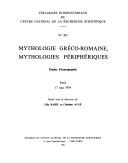| Listing 1 - 10 of 81 | << page >> |
Sort by
|
Book
ISBN: 2130538584 9782130538585 Year: 2003 Volume: 582 Publisher: Paris: PUF,
Abstract | Keywords | Export | Availability | Bookmark
 Loading...
Loading...Choose an application
- Reference Manager
- EndNote
- RefWorks (Direct export to RefWorks)
Book
ISBN: 9781780761701 9781780761695 1780761694 1780761708 Year: 2014 Volume: *6 Publisher: London : I.B. Tauris,
Abstract | Keywords | Export | Availability | Bookmark
 Loading...
Loading...Choose an application
- Reference Manager
- EndNote
- RefWorks (Direct export to RefWorks)
Book
ISBN: 9782070445783 207044578X Year: 2015 Publisher: Paris Gallimard
Abstract | Keywords | Export | Availability | Bookmark
 Loading...
Loading...Choose an application
- Reference Manager
- EndNote
- RefWorks (Direct export to RefWorks)
Déméter, Bellérophon, Oreste, Io, Thésée, Héraclès, Prométhée, Tirésias, Hippolyte, la belle Hélène de Troie... Tous, nous croyons connaître la mythologie grecque car nous en gardons le souvenir de personnages dont les traits et gestes seraient fixés pour l'éternité. Or, montre Claude Calame, rien n'est plus instable et variable que le mythe, sans cesse récrit selon des époques précises, des auteurs singuliers, des fins spécifiques - morales, culturelles ou politiques. Au commencement, il y a toujours un récit intriqué dans sa forme d'énonciation qui lui donne tout son sens. On ne saurait donc dissocier dans le mythe le récit de la source qui le narre : la constitution indigène d'une mythologie (Homère, Hésiode, Orphée) ; les usages qu'en font la poésie chantée (Pindare), la pédagogie (sophistes, rhéteurs), la dramatisation théâtrale (poètes tragiques), voire l'historiographie (Hérodote, Thucydide) et l'iconographie. Claude Calame nous invite, à partir des formes choisies par les poètes, les artistes ou les philosophes, à comprendre ce qu'est l'art du mythe, ses contraintes et ses règles.
Mythology, Greek --- Mythologie grecque --- 292 --- Godsdiensten van Grieken en Romeinen. Klassieke mythologie --- Mythologie grecque.
Book
ISBN: 2070255956 9782070255955 Year: 1981 Publisher: Paris: Gallimard,
Abstract | Keywords | Export | Availability | Bookmark
 Loading...
Loading...Choose an application
- Reference Manager
- EndNote
- RefWorks (Direct export to RefWorks)
Mythology --- #GOSA:VIII.Alg.M --- 292 --- Godsdiensten van Grieken en Romeinen. Klassieke mythologie
Book
ISBN: 9780521861717 0521861713 Year: 2011 Volume: *13 Publisher: Cambridge [etc.] Cambridge University Press
Abstract | Keywords | Export | Availability | Bookmark
 Loading...
Loading...Choose an application
- Reference Manager
- EndNote
- RefWorks (Direct export to RefWorks)
"This is the first history of epiphany as both a phenomenon and a cultural discourse within the Graeco-Roman world. It explores divine manifestations and their representations not only in art but also in literary, historical and epigraphic accounts, and sets the cultural analysis of this unfamiliar conceptual phenomenon within a historical framework that explores its development from the archaic period to the Roman Empire. In particular, a surprisingly large number of the surviving images from antiquity are not only religious but epiphanically charged. Verity Platt argues that the enduring potential for divine incursions into mortal experience provides a reliable cognitive structure which supports both ancient religion and mythology. At the same time, Graeco-Roman culture exhibits a sophisticated awareness of the difficulties and ambiguities in apprehending deity and representing the divine presence, and of the potential for the manmade sign to lead the worshipper back to an unmediated epiphanic encounter"--
Epiphany in art --- Epiphanie dans l'art --- Rome --- Greece --- Grèce --- Religion. --- Civilization. --- Religion --- Civilisation --- Epiphany in art. --- 292 --- -Godsdiensten van Grieken en Romeinen. Klassieke mythologie --- History --- General --- General. --- Grèce --- Godsdiensten van Grieken en Romeinen. Klassieke mythologie

ISBN: 3534038398 9783534038398 Year: 1988 Publisher: Darmstadt: Wissenschaftliche Buchgesellschaft,
Abstract | Keywords | Export | Availability | Bookmark
 Loading...
Loading...Choose an application
- Reference Manager
- EndNote
- RefWorks (Direct export to RefWorks)
Comparative religion --- Antiquity --- Rome --- Greece --- Religion --- 292 --- Godsdiensten van Grieken en Romeinen. Klassieke mythologie --- Religion. --- Greece - Religion --- Rome - Religion

ISBN: 222202692X 9782222026921 Year: 1981 Volume: 593 Publisher: Paris: CNRS,
Abstract | Keywords | Export | Availability | Bookmark
 Loading...
Loading...Choose an application
- Reference Manager
- EndNote
- RefWorks (Direct export to RefWorks)
Book
ISBN: 3201009083 9783201009089 Year: 1975 Publisher: Graz: Akademische Druck- und Verlagsanstalt,
Abstract | Keywords | Export | Availability | Bookmark
 Loading...
Loading...Choose an application
- Reference Manager
- EndNote
- RefWorks (Direct export to RefWorks)
Comparative religion --- Antiquity --- Italy --- Etruscans --- Etrusques --- Religion --- -292 --- Civilization, Etruscan --- Etrurians --- Ethnology --- Italic peoples --- Godsdiensten van Grieken en Romeinen. Klassieke mythologie --- Religion. --- 292 --- Etruscans - Religion
Book
ISBN: 2130381693 9782130381693 Year: 1984 Volume: 2135 Publisher: Paris: PUF,
Abstract | Keywords | Export | Availability | Bookmark
 Loading...
Loading...Choose an application
- Reference Manager
- EndNote
- RefWorks (Direct export to RefWorks)
Comparative religion --- Divination --- History --- -292 --- 292 --- Augury --- Soothsaying --- Occultism --- Worship --- Godsdiensten van Grieken en Romeinen. Klassieke mythologie --- History. --- Divination - History --- Antiquite
Book
ISBN: 9044300229 Year: 2000 Publisher: Vianen : The House of Books,
Abstract | Keywords | Export | Availability | Bookmark
 Loading...
Loading...Choose an application
- Reference Manager
- EndNote
- RefWorks (Direct export to RefWorks)
Mythologie --- mythologie --- 292 <03> --- Godsdiensten van Grieken en Romeinen. Klassieke mythologie--Naslagwerken. Referentiewerken --- woordenboeken --- woordenboeken. --- mythologie (genre) --- Comparative religion --- Woordenboeken. --- #gsdbF
| Listing 1 - 10 of 81 | << page >> |
Sort by
|

 Search
Search Feedback
Feedback About UniCat
About UniCat  Help
Help News
News